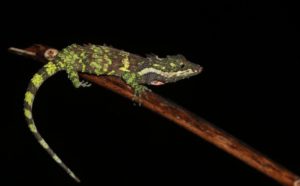
Cophotis is an endemic genus to Sri Lanka and there are 2 species under that. Cophotis ceylanica and Cophotis dumbara. Cophotis species are distinguished from other agamids by the long snout, prehensile tail, indistinct tympanum and backward-pointed, large, irregular scales on the dorsal aspect of the body. Cophotis dumbara males have small, distinct gular sack. Distinguished from C.ceylanica by smoothly pointed gular sack scales which are keeled only at the posterior end. Dull yellowish-green in color. Diurnal, arboreal and slow-moving. Found in the moss-covered tree trunk (near cardamom plantations). It can jump 2-3 feet to reach another branch. Has the ability to rotate eyes like chamaeleons.
A grown-up arrives at 60.0 mm SVL long. 111–120 mid-ventral scales. Head rhomboid dorsally. Orbital edge not unmistakable. Supraorbital edge with a column of enormous, carinate scales. There is a supraorbital edge with a column of huge, carinate scales. Nasal scale pentagonal. Supraciliary scales are carinate and lengthen. Tympanum subdermal. Chest scales triangular.
Male has a pale greenish-yellow on the upper lip. Lower lip dull greenish-dark. A light greenish-yellow band reaches out from nose tip to axilla. Blackish loreal and transient districts with light greenish-yellow scales. Student dark. Iris blackish with brilliant shades. Dorsal peak dark, which contains light green patches. The centerpiece of the throat is ruddy orange. Tail comprises of seven greenish-yellow and seven dark cross-groups.
The Female has a buff-shaded throat. Throat with longitudinal dark-colored streaks. Upper and lower lips light dark colored with dark patches. Tail comprises of seven greenish buff and eight dark-colored cross-groups.
Description ( according to the research paper)
Head rhomboid in dorsal perspective; a profile of nose straight; interorbital curved. Orbital edge not unmistakable, the opening of eye moderate. Supraorbital edge with a column of huge, carinate scales. The fleeting area with 3 enormous, pointed scales. The region between upper worldly fossae raised. The dorsal part of rostral member oval, the limb encompassed by the rostral scale and 5 different scales. Cephalic scales unpredictable, generally littler than middorsal scales, smooth or weakly carinate, some of the time cone-shaped, evenly masterminded. Two coterminous, tuberculated scales dorsally among interorbital and internarial districts. Scales on the nose with carinate edges, those on head bent and level. Two tapered bunches of pointed occipital scales, isolated by 1–3 lines of short, wide scales. A pointed scales hard procedure present on the upper edge of the postorbital edge. Canthus rostralis irregular, with smooth or weakly carinate scales; 3 [2, 3] scales from rostral limb to back edge of nasal; 5 [4, 5] scales from nasal to foremost circle, in an orderly fashion when seen along the side. Nostril oval, anterolaterally orientated. Nasal scale huge, pentagonal [hexagonal], on a level plane, orientated, isolated from rostral extremity by 3 [2, 3] scales [or in contact with rostral appendage], focused above second and third supralabials; nasal scale isolated from supralabials by a line of tight scales; nasal scales isolated from one another by 5 [3, 4] littler scopes. Supraciliary scales are carinate, stretch. The second column of scales from inward edges of both upper and lower eyelids enormous, carinate. Supralabials 9 [9, 10]; infralabials 7 on left
The description of an adolescent: head length, 8.5 mm; nose vent length, 29.0 mm; tail length, 29.2 mm. Dorsal scales on head, body, and appendages smooth; horizontal scales on the head and body smooth. Dorsal peak with 12 scales. Gular, chest and ventral scales smooth. Ventral scales on appendages smooth. Caudal and subcaudals are carinate. Tinge in additive: dorsally ashy dark-colored, gular pale darker with dark longitudinal streaks, venter pale dark colored with dark spots, subcaudals white with dark spots.
Distribution: Restricted to cardamom cultivations in the Knuckles range.
Diet: Caterpillars, arthropods, grubs, and ants.
Knuckles Pigmy Lizard References
- “A second species of Cophotis (Reptilia: Agamidae) from the highlands of Sri Lanka” (PDF). Lyriocephalus (Journal of the Amphibia and Reptile Research Organization of Sri Lanka, ARROS), Volume 6, Supplement 1, pp. 1–8 (December, 2006). Retrieved 3 February 2019.
- Samarawickrama, V.; Ranawana, K.; Rajapaksha, D.; Ananjeva, N.B.; Orlov, N.L.; Ranasinghe, J.M.A.S.; Samarawickrama, V.; Manamendra-Arachchi, K.; de Silva, A.; Amarasinghe, T. (2009). “Cophotis dumbara“. IUCN Red List of Threatened Species. IUCN. 2009: e.T169677A6666297. doi:10.2305/IUCN.UK.2009-2.RLTS.T169677A6666297.en. Retrieved 13 January 2020.
- http://reptile-database.reptarium.cz/species?genus=Cophotis&species=dumbara
External links
- http://novataxa.blogspot.com/2011/11/2006-cophotis-dumbarae-srilanka.html
- http://zipcodezoo.com/animals/c/cophotis_dumbara/
- http://www.biologybrowser.org/node/1223170
- http://slendemics.net/easl/reps/Agamidae.html

check out – INTRODUCTION FOR DRAGON LIZARDS






